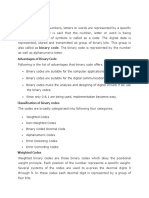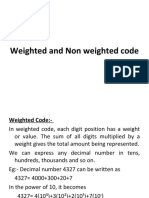Binary Codes: Advantag Es of Binary Code
Uploaded by
Kamalendu Kumar DasBinary Codes: Advantag Es of Binary Code
Uploaded by
Kamalendu Kumar DasBINARY CODES
http://www.tuto rialspo int.co m/co mpute r_lo g ical_o rg aniz atio n/binary_co de s.htm
Co pyrig ht tuto rials po int.co m
In the coding , when numbers, letters or words are represented by a specific g roup of symbols, it is said that the
number, letter or word is being encoded. T he g roup of symbols is called as a code. T he dig ital data is
represented, stored and transmitted as g roup of binary bits. T his g roup is also called as binary c ode. T he
binary code is represented by the number as well as alphanumeric letter.
Advantag es of Binary Code
Following is the list of advantag es that binary code offers.
Binary codes are suitable for the computer applications.
Binary codes are suitable for the dig ital communications.
Binary codes make the analysis and desig ning of dig ital circuits if we use the binary codes.
Since only 0 & 1 are being used, implementation becomes easy.
Classification of binary codes
T he codes are broadly categ orized into following four categ ories.
Weig hted Codes
Non-Weig hted Codes
Binary Coded Decimal Code
Alphanumeric Codes
Error Detecting Codes
Error Correcting Codes
Weig hted Codes
Weig hted binary codes are those binary codes which obey the positional weig ht principle. Each position of the
number represents a specific weig ht. Several systems of the codes are used to express the decimal dig its 0
throug h 9. In these codes each decimal dig it is represented by a g roup of four bits.
Non-Weig hted Codes
In this type of binary codes, the positional weig hts are not assig ned. T he examples of non-weig hted codes are
Excess-3 code and Gray code.
Excess-3 code
T he Excess-3 code is also called as XS-3 code. It is non-weig hted code used to express decimal numbers. T he
Excess-3 code words are derived from the 8421 BCD code words adding (0011)2 or (3)10 to each code word
in 8421. T he excess-3 codes are obtained as follows
Example
Gray Code
It is the non-weig hted code and it is not arithmetic codes. T hat means there are no specific weig hts assig ned to
the bit position. It has a very special feature that has only one bit will chang e, each time the decimal number is
incremented as shown in fig . As only one bit chang es at a time, the g ray code is called as a unit distance code.
T he g ray code is a cyclic code. Gray code cannot be used for arithmetic operation.
Application of Gray code
Gray code is popularly used in the shaft position encoders.
A shaft position encoder produces a code word which represents the ang ular position of the shaft.
Binary Coded Decimal (BCD) code
In this code each decimal dig it is represented by a 4-bit binary number. BCD is a way to express each of the
decimal dig its with a binary code. In the BCD, with four bits we can represent sixteen numbers (0000 to 1111).
But in BCD code only first ten of these are used (0000 to 1001). T he remaining six code combinations i.e. 1010
to 1111 are invalid in BCD.
Advantag es of BCD Codes
It is very similar to decimal system.
We need to remember binary equivalent of decimal numbers 0 to 9 only.
Disadvantag es of BCD Codes
T he addition and subtraction of BCD have different rules.
T he BCD arithmetic is little more complicated.
BCD needs more number of bits than binary to represent the decimal number. So BCD is less efficient than
binary.
Alphanumeric codes
A binary dig it or bit can represent only two symbols as it has only two states '0' or '1'. But this is not enoug h for
communication between two computers because there we need many more symbols for communication. T hese
symbols are required to represent 26 alphabets with capital and small letters, numbers from 0 to 9 , punctuation
marks and other symbols.
T he alphanumeric codes are the codes that represent numbers and alphabetic characters. Mostly such codes
also represent other characters such as symbol and various instructions necessary for conveying information. An
alphanumeric code should at least represent 10 dig its and 26 letters of alphabet i.e. total 36 items. T he following
three alphanumeric codes are very commonly used for the data representation.
American Standard Code for Information Interchang e (ASCII).
Extended Binary Coded Decimal Interchang e Code (EBCDIC).
Five bit Baudot Code.
ASCII code is a 7-bit code whereas EBCDIC is an 8-bit code. ASCII code is more commonly used worldwide
while EBCDIC is used primarily in larg e IBM computers.
Error Codes
T here are binary code techniques available to detect and correct data during data transmission.
Error Code
Desc ription
Error Detection and Correction
Error detection and correction code techniques
You might also like
- CODING SCHEMES-digital electronics SWE L1No ratings yetCODING SCHEMES-digital electronics SWE L115 pages
- Faculty of ICT: Course: DLD Semester Three AssignmentNo ratings yetFaculty of ICT: Course: DLD Semester Three Assignment8 pages
- Unit 2.lesson 4 Numeric and Alphanumeric CodesNo ratings yetUnit 2.lesson 4 Numeric and Alphanumeric Codes61 pages
- Binary, Error Detection & Correction Codes - Logic GatesNo ratings yetBinary, Error Detection & Correction Codes - Logic Gates8 pages
- Basic Digital System Structure: - CPU: - Data Path: - Control Unit: - StorageNo ratings yetBasic Digital System Structure: - CPU: - Data Path: - Control Unit: - Storage22 pages
- Hdpe Boru Fiyat Listesi Hdpe Pipe Price ListNo ratings yetHdpe Boru Fiyat Listesi Hdpe Pipe Price List2 pages
- Instruction Sheet: VIQUA UV Lamp and Quartz Sleeve ReplacementNo ratings yetInstruction Sheet: VIQUA UV Lamp and Quartz Sleeve Replacement5 pages
- Aesthetic Experience: and Literary HermeneuticsNo ratings yetAesthetic Experience: and Literary Hermeneutics389 pages
- Method Acting Reconsidered Theory Practice Future 1st Ed 978 0 312 22309 0978 1 349 62271 9No ratings yetMethod Acting Reconsidered Theory Practice Future 1st Ed 978 0 312 22309 0978 1 349 62271 9302 pages
- The Specifications of DH9920C: Details PDFNo ratings yetThe Specifications of DH9920C: Details PDF1 page
- Julia & Ijulia Cheat-Sheet (For 18.Xxx at Mit, Julia 1.X) : Basics: Arithmetic and Functions of NumbersNo ratings yetJulia & Ijulia Cheat-Sheet (For 18.Xxx at Mit, Julia 1.X) : Basics: Arithmetic and Functions of Numbers1 page
- Manufacturing Process: Project Report (29, Sep. 2019) Title: KANBANNo ratings yetManufacturing Process: Project Report (29, Sep. 2019) Title: KANBAN8 pages
- Purchasing Organization in Enterprise: Supply Chain Management100% (1)Purchasing Organization in Enterprise: Supply Chain Management57 pages
- Draft Old Oak and Park Royal Opportunity Area Planning FrameworkNo ratings yetDraft Old Oak and Park Royal Opportunity Area Planning Framework130 pages
























































































